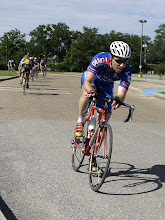It's September. It's time to look back at the accomplishments of the 2006 season and evaluate what whet well and what went wrong. From this retrospect, I'll build the foundation of my 2007 season.
#1. (Negative) Weight was too high the entire season. I had a great 2005 holiday season that lingered into early 2006. Unfortunately, I carried that weight through the summer. I'm only talking 5-10 lbs. but every pound makes a difference when the road turns up.
#2. (Negative/Positive)I started training too late. I don't think I rode over 2 times/week until March. I felt like I was a couple months behind on form for the entire year. On the other hand, much of my time was spent doing research in bicycle fit, neuomuscular effects of pedaling, balance, training, periodization etc. Also, I took time out to pass the USA cycling Level 1 coaching exam. Yes, I know it's a take home test but it takes time to get through the material.
#3. (Positive) I took time to really ingrain my pedaling skills. I still feel like I have a long way to go before I'm really efficient. However, I had very poor mechanics when I got started.
Those are the high points.
Looking forward, here are the goals.
#1. I plan to loose 10 lbs before the end of the year. This will be accomplished by riding regularly at intensities that promote fat for fuel.
#2. I plan to ride most every Saturday as long as I can get it in before family functions. I may ride one early ride a week but most of my training will be at home on the rollers or on the computrainer for the next several months. Once the weight goal is achieved, I'll included more road rides for fitness.
#3. I plan to integrate a stretching, strengthening and neuromuscular control programs into my fall and winter training. This will be new. In the past, I have focused on riding only.
#4. I plan to integrate mountain biking for a bit of crosstraining. I thought about ballet......no.
It's not a big plan but it's a starting point. During these next few weeks, I anticipate that I will be on the rollers 4-5 hours per week and have a 3 hour ride on the weekends. That should be enough to accomplish the early goals and enjoy my fall. The exercise program will probably be another 2 hours per week in 30 minute sessions.
I'll keep you posted.

